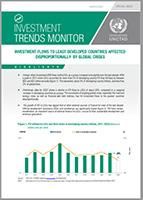
The monitor shows that investment flows to the LDCs have been disproportionally affected by the ongoing multidimensional crises.
Highlights:
-
Foreign direct investment (FDI) flows to the LDCs as a group increased only slightly over the last decade. After a peak in 2015 when LDCs accounted for more than 5% of developing country FDI they fell back to between $20 and $25 billion annually. This represents about 3% of developing-country inflows, and less than 2% of global flows.
-
Preliminary data for 2022 shows a possible decline in FDI flows to LDCs of about 30%, compared to a marginal increase in developing countries as a group.
-
The impact of the multi-dimensional crises is evident across all types of investment flows. International project finance (IPF) suffered the most, with the number of deals 42% lower than in 2019. The number of greenfield project announcements fell by 55% over the same period. This is a major concern for LDCs, because both investment types are crucial for the build-up of productive capacity and essential infrastructure, and thus for sustainable development prospects.
-
While the list of top FDI recipients changed markedly over the past decade, flows remained concentrated, with the top five recipients accounting for about 55% of the total.
-
Extractive industries remain among the top recipient sectors for international project finance deals and greenfield investment projects, pointing to the continued dependence of LDCs on this sector and on resource-driven FDI. Nevertheless, several LDCs are seeing some sectoral diversification.
-
Investment activity in LDCs in sectors relevant for the attainment of the SDGs - infrastructure, renewables, water and sanitation, food security, health and education - suffered a significant blow in 2021-2022. Comparing with 2015 when the SDGs were adopted, project numbers in the last two years were significantly lower in most sectors except for renewables and water and sanitation.
-
Cross-border investment in climate change mitigation in LDCs showed an upward trend after 2015. However, it remains small compared to developing economies as a group.


